《管理学英语》参考译文Unit 1
- 格式:doc
- 大小:87.50 KB
- 文档页数:11

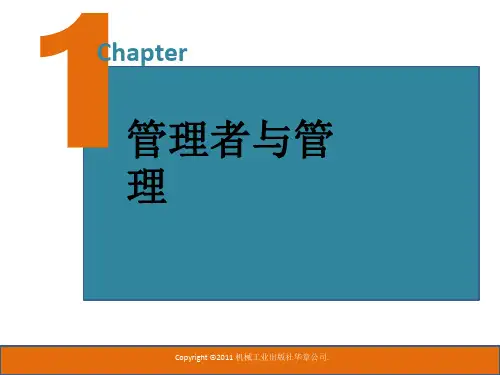
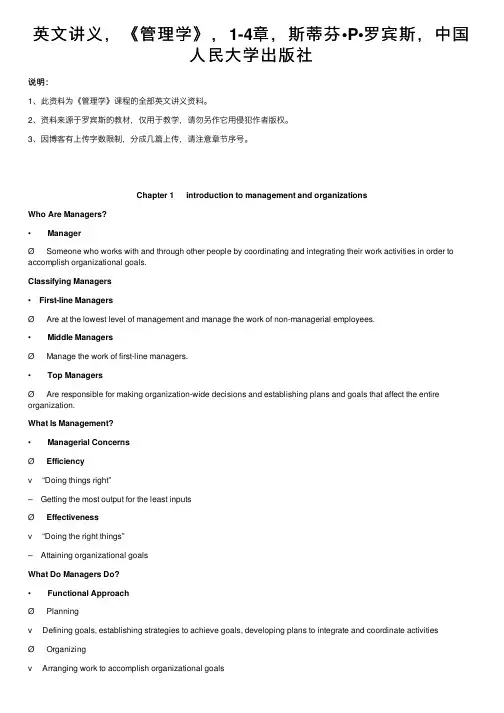
英⽂讲义,《管理学》,1-4章,斯蒂芬•P•罗宾斯,中国⼈民⼤学出版社说明:1、此资料为《管理学》课程的全部英⽂讲义资料。
2、资料来源于罗宾斯的教材,仅⽤于教学,请勿另作它⽤侵犯作者版权。
3、因博客有上传字数限制,分成⼏篇上传,请注意章节序号。
Chapter 1 introduction to management and organizationsWho Are Managers?• ManagerØ Someone who works with and through other people by coordinating and integrating their work activities in order to accomplish organizational goals.Classifying Managers• First-line ManagersØ Are at the lowest level of management and manage the work of non-managerial employees.• Middle ManagersØ Manage the work of first-line managers.• Top ManagersØ Are responsible for making organization-wide decisions and establishing plans and goals that affect the entire organization.What Is Management?• Managerial ConcernsØ Efficiencyv “Doing things right”– Getting the most output for the least inputsØ Effectivenessv “Doing the right things”– Attaining organizational goalsWhat Do Managers Do?• Functional ApproachØ Planningv Defining goals, establishing strategies to achieve goals, developing plans to integrate and coordinate activitiesØ Organizingv Arranging work to accomplish organizational goalsØ Leadingv Working with and through people to accomplish goals.Ø Controllingv Monitoring, comparing, and correcting the work• Management Roles ApproachØ Interpersonal rolesv Figurehead, leader, liaisonØ Informational rolesv Monitor, disseminator, spokespersonØ Decisional rolesv Disturbance handler, resource allocator, negotiator• Skills ApproachØ Technical skillsv Knowledge and proficiency in a specific fieldØ Human skillsv The ability to work well with other peopleØ Conceptual skillsv The ability to think and conceptualize about abstract and complex situations concerning the organization How The Manager’s Job Is Changing• The Increasing Importance of CustomersØ Customers: the reason that organizations existv Managing customer relationships is the responsibility of all managers and employees.v Consistent high quality customer service is essential for survival.• InnovationØ Doing things differently, exploring new territory, and taking risksv Managers should encourage employees to be aware of and act on opportunities for innovation.What Is An Organization?• An Organization DefinedØ A deliberate arrangement of people to accomplish some specific purpose• Common Characteristics of OrganizationsØ Have a distinct purpose (goal)Ø Composed of peopleØ Have a deliberate structureWhy Study Management?• The Value of Studying ManagementØ The universality of managementv Good management is needed in all organizations.Ø The reality of workv Employees either manage or are managed.Ø Rewards and challenges of being a managerv Management offers challenging, exciting and creative opportunities for meaningful and fulfilling work. v Successful managers receive significant monetary rewards for their efforts.Chapter 2 management yesterday and todayHistorical Background of Management• Ancient ManagementØ Egypt (pyramids) and China (Great Wall)Ø Venetians (floating warship assembly lines)• Adam SmithØ Published “The Wealth of Nations” in 1776v Advocated the division of labor (job specialization) to increase the productivity of workers• Industrial RevolutionØ Substituted machine power for human laborØ Created large organizations in need of managementMajor Approaches to Management• Scientific Management• General Administrative Theory• Quantitative Management• Organizational Behavior• Systems Approach• Contingency ApproachScientific Management• Fredrick Winslow TaylorØ The “father” of scientific managementØ Published Principles of Scientific Management (1911)v The theory of scientific management:– Using scientific methods to define the “one best way” for a job to be done• Putting the right person on the job with the correct tools and equipment• Having a standardized method of doing the job• Providing an economic incentive to the worker• Frank and Lillian GilbrethØ Focused on increasing worker productivity through the reduction of wasted motionØ Developed the microchronometer to time worker motions and optimize performance.• How Do Today’s Managers Use Scientific Management?Ø Use time and motion studies to increase productivityØ Hire the best qualified employeesØ Design incentive systems based on outputGeneral Administrative Theorists• Henri FayolØ Believed that the practice of management was distinct from other organizational functionsØ Developed fourteen principles of management that applied to all organizational situations• Max WeberØ Developed a theory of authority based on an ideal type of organization (bureaucracy)v Emphasized rationality, predictability, impersonality, technical competence, and authoritarianism. Quantitative Approach to Management• Quantitative ApproachØ Also called operations research or management scienceØ Evolved from mathematical and statistical methods developed to solve WWII military logistics and quality control problemsØ Focuses on improving managerial decision making by applying:v Statistics, optimization models, information models, and computer simulationsUnderstanding Organizational Behavior• Organizational Behavior (OB)Ø The study of the actions of people at work; people are the most important asset of an organization• Early OB AdvocatesØ Robert OwenØ Hugo MunsterbergØ Mary Parker FollettØ Chester BarnardThe Hawthorne Studies• A series of productivity experiments conducted at Western Electric from 1927 to 1932.• Experimental findingsØ Productivity unexpectedly increased under imposed adverse working conditions.Ø The effect of incentive plans was less than expected.• Research conclusionØ Social norms, group standards and attitudes more strongly influence individual output and work behavior than domonetary incentives.The Systems Approach• System DefinedØ A set of interrelated and interdependent parts arranged in a manner that produces a unified whole.• Basic Types of SystemsØ Closed systemsv Are not influenced by and do not interact with their environment (all system input and output is internal)Ø Open systemsv Dynamically interact to their environments by taking in inputs and transforming them into outputs that are distributed into their environmentsImplications of the Systems Approach• Coordination of the organization’s parts is essential for proper functioning of the entire organization.• Decisions and actions taken in one area of the organization will have an effect in other areas of the organization.• Organizations are not self-contained and, therefore, must adapt to changes in their external environment.The Contingency Approach• Contingency Approach DefinedØ Also sometimes called the situational approach.Ø There is no one universally applicable set of management principles (rules) by which to manage organizations.Ø Organizations are individually different, face different situations (contingency variables), and require different ways of managing.Current Trends and Issues• Globalization• Ethics• Workforce Diversity• Entrepreneurship• E-business• Knowledge Management• Learning Organizations• Quality Management• Globalization• Management in international organizations• Political and cultural challenges of operating in a global market• Ethics• Increased emphasis on ethics education in college curriculums• Increased creation and use of codes of ethics by businesses• Workforce Diversity• Increasing heterogeneity in the workforce• More gender, minority, ethnic, and other forms of diversity in employees• Aging workforce• Older employees who work longer and not retire• The cost of public and private benefits for older workers will increase• Increased demand for products and services related to aging• Entrepreneurship Defined• The process whereby an individual or group of individuals use organized efforts to create value and grow by fulfilling wants and needs through innovation and uniqueness.• Entrepreneurship process• Pursuit of opportunities• Innovation in products, services, or business methods• Desire for continual growth of the organization• E-Business (Electronic Business)• The work preformed by an organization using electronic linkages to its key constituencies• E-commerce: the sales and marketing component of an e-business• Categories of E-Businesses• E-business enhanced organization• E-business enabled organization• Total e-business organization• Knowledge Management• The cultivation of a learning culture where organizational members systematically gather and share knowledge with others in order to achieve better performance.• Learning Organization• An organization that has developed the capacity to continuously learn, adapt, and change.• Quality Management• A philosophy of management driven by continual improvement in the quality of work processes and responding to customer needs and expectations• Inspired by the total quality management (TQM) ideas of Deming and Juran• Quality is not directly related to cost.Chapter 3 organizational culture and the environment : the constraintsThe Manager: Omnipotent or Symbolic?• Omnipotent View of ManagementØ Managers are directly responsible for an organization’s success or failure.Ø The quality of the organization is determined by the quality of its managers.Ø Managers are held most accountablefor an organization’s performanceyet it is difficult to attributegood or poor performancedirectly to their influenceon the organization.• Symbolic View of ManagementØ Much of an organization’s success or failure is due to external forces outside of managers’ control.Ø The ability of managers to affect outcomes is influenced and constrained by external factors.• The economy, customers, governmental policies, competitors, industry conditions,technology, and the actions ofprevious managersØ Managers symbolize control andinfluence through their actionThe Organization’s Culture• Organizational CultureØ A system of shared meanings and common beliefs held by organizational members that determines, in a large degree, how they act towards each other.Ø “The way we do things around here.”v Values, symbols, rituals, myths, and practicesØ Implications:v Culture is a perception.v Culture is shared.v Culture is descriptiveStrong versus Weak Cultures• Strong CulturesØ Are cultures in which key values are deeply held and widely held.Ø Have a strong influence on organizational members.• Factors Influencing the Strength of CultureØ Size of the organizationØ Age of the organizationØ Rate of employee turnoverØ Strength of the original cultureØ Clarity of cultural values and beliefsBenefits of a Strong Culture• Creates a stronger employee commitment to the organization.• Aids in the recruitment and socialization of new employees.• Fosters higher organizationalperformance by instilling andpromoting employee initiativeOrganizational Culture• Sources of Organizational CultureØ The organization’s founderv Vision and missionØ Past practices of the organizationv The way things have been doneØ The behavior of top management• Continuation of the Organizational CultureØ Recruitment of like-minded employees who “fit.”Ø Socialization of new employees to help them adapt to the cultureHow Employees Learn Culture• StoriesØ Narratives of significant events or actions of people that convey the spirit of the organization • RitualsØ Repetitive sequences of activities that express and reinforce the values of the organization • Material SymbolsØ Physical assets distinguishing the organization• LanguageØ Acronyms and jargon of terms, phrases, and word meanings specific to an organization How Culture Affects Managers• Cultural Constraints on ManagersØ Whatever managerial actions the organization recognizes as proper or improper on its behalf Ø Whatever organizational activities the organization values and encouragesØ The overall strength or weakness of the organizational cultureSimple rule for getting ahead in an organization:Find out what the organization rewards and do those things.Organization Culture Issues• Creating an Ethical CultureØ High in risk toleranceØ Low to moderate aggressivenessØ Focus on means as well as outcomes• Creating an Innovative CultureØ Challenge and involvementØ FreedomØ Trust and opennessØ Idea timeØ Playfulness/humorØ Conflict resolutionØ DebatesØ Risk-taking• Creating a Customer-Responsive CultureØ Hiring the right type of employees (ones with a strong interest in serving customers)Ø Having few rigid rules, procedures, and regulationsØ Using widespread empowerment of employeesØ Having good listening skills in relating to customers’ messagesØ Providing role clarity to employees to reduce ambiguity and conflict and increase job satisfactionØ Having conscientious, caring employees willing to take initiativeSpirituality and Organizational Culture• Workplace SpiritualityØ The recognition that people have an inner life that nourishes and is nourished by meaningful work that takes place in the context of community.• Characteristics of a Spiritual OrganizationØ Strong sense of purposeØ Focus on individual developmentØ Trust and opennessØ Employee empowermentØ Toleration of employees’ expressionBenefits of Spirituality• Improved employee productivity• Reduction of employee turnover• Stronger organizational performance• Increased creativity• Increased employee satisfaction• Increased team performance• Increased organizational performanceDefining the External Environment• External EnvironmentØ The forces and institutions outside the organization that potentially can affect the organization’s performance.• Components of the External EnvironmentØ Specific environment: external forces that have a direct and immediate impact on the organization.Ø General environment: broad economic, socio-cultural, political/legal, demographic, technological, and global conditions that may affect the organization.How the Environment Affects Managers• Environmental UncertaintyØ The extent to which managers have knowledge of and are able to predict change their organization’s external environment is affected by:v Complexity of the environment: the number of components in an organization’s external environment.v Degree of change in environmental components: how dynamic or stable the external environment is. Stakeholder Relationships• StakeholdersØ Any constituencies in the organization’s external environment that are affected by the organization’s decisions and actions• Why Manage Stakeholder Relationships?Ø It can lead to improved organizational performance.Ø It’s the “right” thing to do given the interdependence of the organization and its external stakeholders. Managing Stakeholder Relationships1. Identify the organization’s external stakeholders.2. Determine the particular interests and concerns of the external stakeholders.3. Decide how critical each external stakeholder is to the organization.4. Determine how to manage each individual external stakeholder relationship.Chapter 4 managing in a global environmentManaging in a Global Environment• ChallengesØ Coping with the sudden appearance of new competitorsØ Acknowledging cultural, political, and economic differencesØ Dealing with increased uncertainty, fear, and anxietyØ Adapting to changes in the global environmentØ Avoiding parochialismAdopting a Global Perspective• Ethnocentric AttitudeØ The parochialistic belief that the best work approaches and practices are those of the home country.• Polycentric AttitudeØ The view that the managers in the host country know the best work approaches and practices for running their business.• Geocentric AttitudeØ A world-oriented view that focuses on using the best approaches and people from around the globe.Regional Trading Agreements• The European Union (EU)Ø A unified economic and trade entityv Belgium, Denmark, France, Greece, Ireland, Italy, Luxembourg, the Netherlands, Portugal, Spain, the United Kingdom, Germany, Austria, Finland, and SwedenØ Economic and monetary union (Euro)• North American Free Trade Agreement (NAFTA)Ø Eliminated barriers to free trade (tariffs, import licensing requirements, and customs user fees)v United States, Canada, and Mexico• Free Trade Area of the Americas• Southern Cone Common Market (Mercosur)• Association of Southeast Asian Nations (ASEAN)Ø Trading alliance of 10 Southeast Asian nations• African UnionThe World Trade Organization (WTO)• Evolved from the General Agreement on Tariffs and Trade (GATT) in 1995.• Functions as the only global organization dealing with the rules of trade among nations.• Has 145 member nations.• Monitors and promotes world trade.Different Types of Global Organizations• Multinational Corporation (MNC)Ø A firm which maintains operations in multiple countries but manages the operations from a base in the home country.• Transnational Corporation (TNC)Ø A firm that maintains operations in several countries but decentralizes management to the local country.• Borderless OrganizationØ A firm that has eliminated structural divisions that impose artificial geographic barriers and is organized along business lines.How Organizations Go Global• Three Stages of GlobalizationØ Stage Iv Exporting products for sale overseas and importing products from overseas to sell in the home country.Ø Stage IIv Committing to directly sell home-country products in overseas markets or contracting for products to be manufactured overseas and sold in the home country.Ø Stage IIIv Licensing manufacturing and franchising services to foreign firms to use the brand name, technology, or product specifications developed by the firm.Other Forms of Globalization• Strategic AlliancesØ Partnerships between and organization and a foreign company in which both share resources and knowledge in developing new products or building new production facilities.• Joint VentureØ A specific type of strategic alliance in which the partners agree to form a separate, independent organization for some business purpose.Managing in A Global Environment• The Legal EnvironmentØ Stability or instability of legal and political systemsv Legal procedures are established and followedv Fair and honest elections held on a regular basisØ Differences in the laws of various nationsv Effects on business activitiesv Effects on delivery of products and servicesThe Economic Environment• Economic SystemsØ Market economyv An economy in which resources are primarily owned and controlled by the private sector.Ø Command economyv An economy in which all economic decisions are planned by a central government.• Monetary and Financial FactorsØ Currency exchange ratesØ Inflation ratesØ Diverse tax policiesThe Cultural Environment• National CultureØ Is the values and attitudes shared by individuals from a specific country that shape their behavior and their beliefs about what is important.Ø May have more influence on an organization than the organization culture.Hofstede’s Framework for Assessing Cultures• Individualism versus Collectivism• Power Distance• Uncertainty Avoidance• Quantity versus Quality of Life• Long-term versus Short-term OrientationØ Individualism: the degree to which people in a country prefer to act as individuals.Ø Collectivism: a social framework in whichThe GLOBE (Global Leadership and Organizational Behavior Effectiveness) Framework for Assessing Cultures• Assertiveness• Future orientation• Gender differentiation • Uncertainty avoidance • Power distance• Individualism/collectivism • In-group collectivism • Performance orientation • Humane orientation。
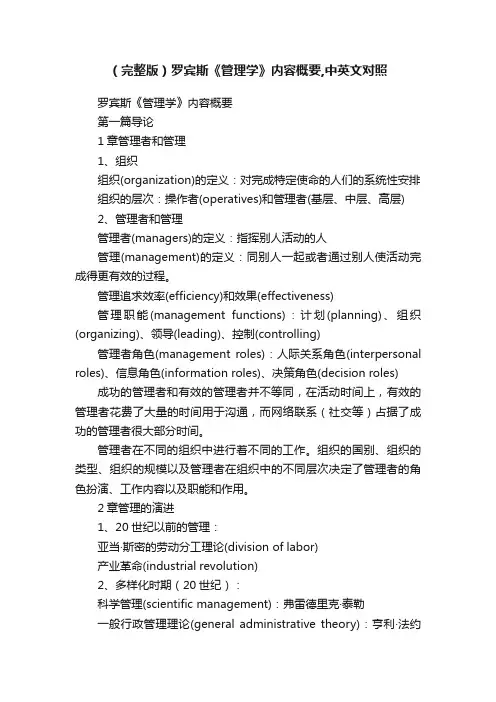
(完整版)罗宾斯《管理学》内容概要,中英文对照罗宾斯《管理学》内容概要第一篇导论1章管理者和管理1、组织组织(organization)的定义:对完成特定使命的人们的系统性安排组织的层次:操作者(operatives)和管理者(基层、中层、高层)2、管理者和管理管理者(managers)的定义:指挥别人活动的人管理(management)的定义:同别人一起或者通过别人使活动完成得更有效的过程。
管理追求效率(efficiency)和效果(effectiveness)管理职能(management functions):计划(planning)、组织(organizing)、领导(leading)、控制(controlling)管理者角色(management roles):人际关系角色(interpersonal roles)、信息角色(information roles)、决策角色(decision roles) 成功的管理者和有效的管理者并不等同,在活动时间上,有效的管理者花费了大量的时间用于沟通,而网络联系(社交等)占据了成功的管理者很大部分时间。
管理者在不同的组织中进行着不同的工作。
组织的国别、组织的类型、组织的规模以及管理者在组织中的不同层次决定了管理者的角色扮演、工作内容以及职能和作用。
2章管理的演进1、20世纪以前的管理:亚当·斯密的劳动分工理论(division of labor)产业革命(industrial revolution)2、多样化时期(20世纪):科学管理(scientific management):弗雷德里克·泰勒一般行政管理理论(general administrative theory):亨利·法约尔(principles of management)、马克斯·韦伯(bureaucracy) 人力资源方法(human resources approach):权威的接受观点(acceptance view of authority),霍桑研究,人际关系运动(卡内基、马斯洛),行为科学理论家(behavioral science theorists) 定量方法(quantitative approach)3、近年来的趋势(20世纪后期):趋向一体化过程方法(process approach)系统方法(systems approach):封闭系统和开放系统(closed systems)权变方法(contingency approach):一般性的权变变量包括组织规模、任务技术的例常性、环境的不确定性、个人差异4、当前的趋势和问题(21世纪):变化中的管理实践全球化(globalization)工作人员多样化(work force diversity)道德(morality)激励创新(innovations)和变革(changes)全面质量管理(total quality management, TQM):由顾客需要和期望驱动的管理哲学授权(delegation)工作人员的两极化(bi-modal work force)3章组织文化与环境:管理的约束力量1、组织组织文化(organizational culture)被用来指共有的价值体系。
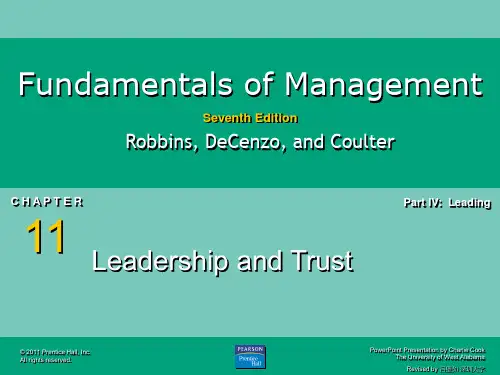
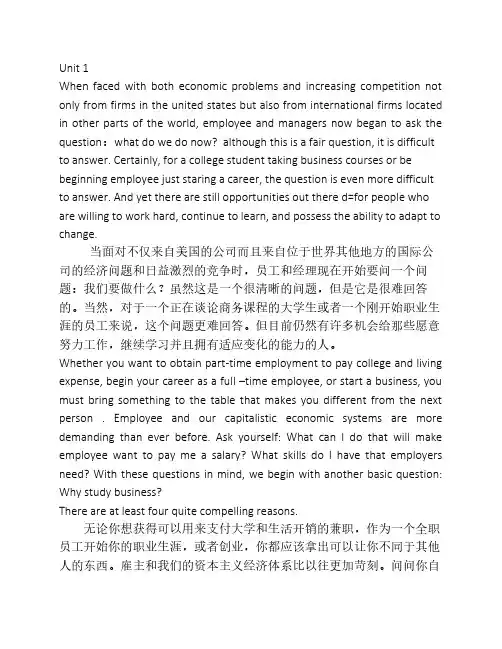
Unit 1When faced with both economic problems and increasing competition not only from firms in the united states but also from international firms located in other parts of the world, employee and managers now began to ask the question:what do we do now? although this is a fair question, it is difficult to answer. Certainly, for a college student taking business courses or be beginning employee just staring a career, the question is even more difficult to answer. And yet there are still opportunities out there d=for people who are willing to work hard, continue to learn, and possess the ability to adapt to change.当面对不仅来自美国的公司而且来自位于世界其他地方的国际公司的经济问题和日益激烈的竞争时,员工和经理现在开始要问一个问题:我们要做什么?虽然这是一个很清晰的问题,但是它是很难回答的。
当然,对于一个正在谈论商务课程的大学生或者一个刚开始职业生涯的员工来说,这个问题更难回答。
但目前仍然有许多机会给那些愿意努力工作,继续学习并且拥有适应变化的能力的人。
Whether you want to obtain part-time employment to pay college and living expense, begin your career as a full –time employee, or start a business, you must bring something to the table that makes you different from the next person . Employee and our capitalistic economic systems are more demanding than ever before. Ask yourself: What can I do that will make employee want to pay me a salary? What skills do I have that employers need? With these questions in mind, we begin with another basic question: Why study business?There are at least four quite compelling reasons.无论你想获得可以用来支付大学和生活开销的兼职,作为一个全职员工开始你的职业生涯,或者创业,你都应该拿出可以让你不同于其他人的东西。
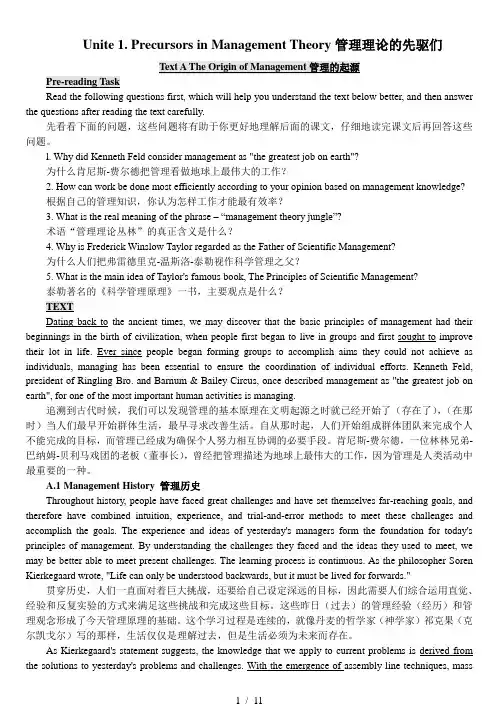
Unite 1. Precursors in Management Theory管理理论的先驱们Read the following questions first, which will help you understand the text below better, and then answer the questions after reading the text carefully.先看看下面的问题,这些问题将有助于你更好地理解后面的课文,仔细地读完课文后再回答这些问题。
l. Why did Kenneth Feld consider management as "the greatest job on earth"?为什么肯尼斯-费尔德把管理看做地球上最伟大的工作?2. How can work be done most efficiently according to your opinion based on management knowledge?根据自己的管理知识,你认为怎样工作才能最有效率?3. What is the real meaning of the phrase –“management theory jungle”?术语“管理理论丛林”的真正含义是什么?4. Why is Frederick Winslow Taylor regarded as the Father of Scientific Management?为什么人们把弗雷德里克-温斯洛-泰勒视作科学管理之父?5. What is the main idea of Taylor's famous book, The Principles of Scientific Management?泰勒著名的《科学管理原理》一书,主要观点是什么?Dating back to the ancient times, we may discover that the basic principles of management had their beginnings in the birth of civilization, when people first began to live in groups and first sought to improve their lot in life. Ever since people began forming groups to accomplish aims they could not achieve as individuals, managing has been essential to ensure the coordination of individual efforts. Kenneth Feld, president of Ringling Bro. and Barnum & Bailey Circus, once described management as "the greatest job on earth", for one of the most important human activities is managing.追溯到古代时候,我们可以发现管理的基本原理在文明起源之时就已经开始了(存在了),(在那时)当人们最早开始群体生活,最早寻求改善生活。
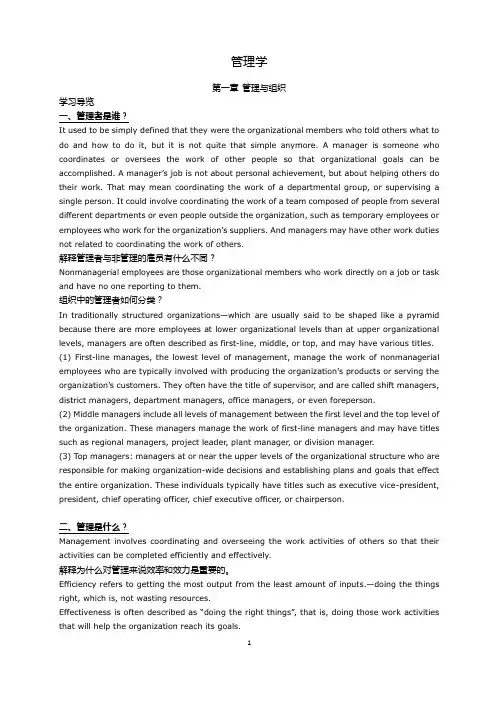
管理学第一章管理与组织学习导览一、管理者是谁?It used to be sim ply defined that they were the organizational m em bers who told others what to do and how to do it, but it is not quite that sim ple anym ore. A m anager is som eone who coordinates or oversees the work of other people so that organizational goals can be accom plished. A m anager’s job is not about personal achievem ent, but about helping others do their work. That m ay m ean coordinating the work of a departm ental group, or supervising a single person. It could involve coordinating the work of a team com posed of people from several different departm ents or even people outside the organization, such as tem porary em ployees or em ployees who work for the organization’s suppliers. And m anagers m ay have other work duties not related to coordinating the work of others.解释管理者与非管理的雇员有什么不同?Nonm anagerial em ployees are those organizational m em bers who work directly on a job or task and have no one reporting to them.组织中的管理者如何分类?In traditionally structured organizations—whi ch are usually said to be shaped like a pyram id because there are m ore em ployees at lower organizational levels than at upper organizational levels, m anagers are often described as first-line, m iddle, or top, and m ay have various titles.(1) First-line m anages, the lowest level of m anagem ent, m anage the work of nonm anagerial em ployees who are typically involved with producing the organization’s products or serving the organization’s custom ers. They often have the title of supervisor, and are called shift m anagers, district m anagers, departm ent m anagers, offi ce m anagers, or even foreperson.(2) Middle m anagers include all levels of m anagem ent between the first level and the top level of the organization. These m anagers m anage the work of first-line m anagers and m ay have titles such as regional m anagers, project leader, plant m anager, or division m anager.(3) Top m anagers: m anagers at or near the upper levels of the organizational structure who are responsible for m aking organization-wide deci sions and establishing plans and goals that effect the entire organization. These individuals typically have ti tles such as executive vice-president, president, chief operating officer, chief executive offi cer, or chairperson.二、管理是什么?Managem ent involves coordinating and overseeing the work activities of others so that their activities can be com pleted efficiently and effecti vely.解释为什么对管理来说效率和效力是重要的。
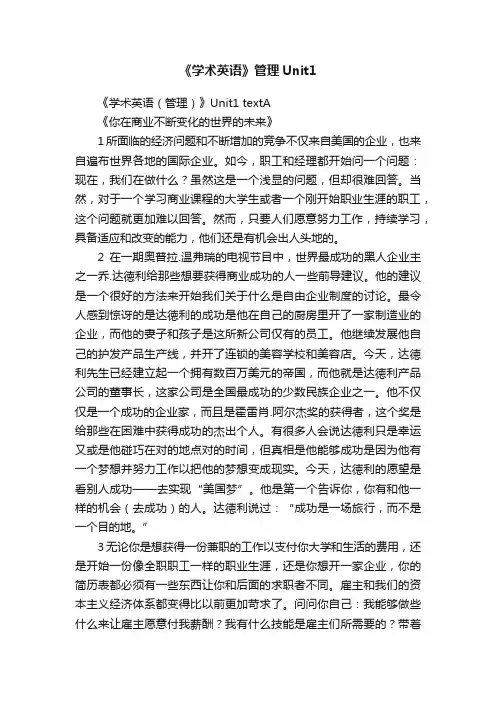
《学术英语》管理Unit1《学术英语(管理)》Unit1 textA《你在商业不断变化的世界的未来》1所面临的经济问题和不断增加的竞争不仅来自美国的企业,也来自遍布世界各地的国际企业。
如今,职工和经理都开始问一个问题:现在,我们在做什么?虽然这是一个浅显的问题,但却很难回答。
当然,对于一个学习商业课程的大学生或者一个刚开始职业生涯的职工,这个问题就更加难以回答。
然而,只要人们愿意努力工作,持续学习,具备适应和改变的能力,他们还是有机会出人头地的。
2在一期奥普拉.温弗瑞的电视节目中,世界最成功的黑人企业主之一乔.达徳利给那些想要获得商业成功的人一些前导建议。
他的建议是一个很好的方法来开始我们关于什么是自由企业制度的讨论。
最令人感到惊讶的是达徳利的成功是他在自己的厨房里开了一家制造业的企业,而他的妻子和孩子是这所新公司仅有的员工。
他继续发展他自己的护发产品生产线,并开了连锁的美容学校和美容店。
今天,达徳利先生已经建立起一个拥有数百万美元的帝国,而他就是达徳利产品公司的董事长,这家公司是全国最成功的少数民族企业之一。
他不仅仅是一个成功的企业家,而且是霍雷肖.阿尔杰奖的获得者,这个奖是给那些在困难中获得成功的杰出个人。
有很多人会说达徳利只是幸运又或是他碰巧在对的地点对的时间,但真相是他能够成功是因为他有一个梦想并努力工作以把他的梦想变成现实。
今天,达徳利的愿望是看别人成功——去实现“美国梦”。
他是第一个告诉你,你有和他一样的机会(去成功)的人。
达徳利说过:“成功是一场旅行,而不是一个目的地。
”3无论你是想获得一份兼职的工作以支付你大学和生活的费用,还是开始一份像全职职工一样的职业生涯,还是你想开一家企业,你的简历表都必须有一些东西让你和后面的求职者不同。
雇主和我们的资本主义经济体系都变得比以前更加苛求了。
问问你自己:我能够做些什么来让雇主愿意付我薪酬?我有什么技能是雇主们所需要的?带着这两个问题:我们开始有了另外一个根本问题:为什么要学习经商呢?4这至少有四个令人十分信服(compelling)的理由。

管理学英语参考译文U n i t(总22页)本页仅作为文档封面,使用时可以删除This document is for reference only-rar21year.MarchUnit 3 The First Function of Management管理的首要职能and then answer the questions after reading the text carefully.先看看下面的问题,这些问题将有助于你更好地理解后面的课文,仔细地读完课文后再回答这些问题。
1. Do you agree with the saying "Planning is the first function of management"你同意“计划是管理的首要职能”这一说法吗2. Why do you think planning in an organizational setting is more complex为什么你认为计划在组织设置(体系)中是最复杂的吗3. What do managers usually do while they are making plans for their enterprises当管理者为他们的企业制定计划时,通常他们会做什么呢4. How do you understand the sentence "Planning involves selecting the missions and objectives as well as the actions to achieve them"你怎么理解“计划包括选择任务和目标以及实现它们的相关行动”这句话5. What does the last sentence in the passage "A necessary first step in planning is to这篇文章的最后一句话“计划中必要的第一步是要”干什么steps involved seem simple. The basic planning process consists of assessing the environment and prediction of the future, setting goals, developing alternative courses of action, selecting the best one, implementing it, and monitoring progress.计划是管理的首要职能。
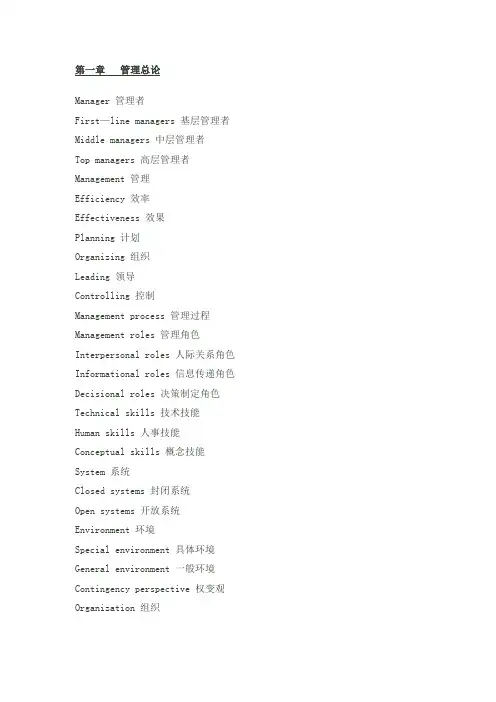
第一章管理总论Manager 管理者First—line managers 基层管理者Middle managers 中层管理者Top managers 高层管理者Management 管理Efficiency 效率Effectiveness 效果Planning 计划Organizing 组织Leading 领导Controlling 控制Management process 管理过程Management roles 管理角色Interpersonal roles 人际关系角色Informational roles 信息传递角色Decisional roles 决策制定角色Technical skills 技术技能Human skills 人事技能Conceptual skills 概念技能System 系统Closed systems 封闭系统Open systems 开放系统Environment 环境Special environment 具体环境General environment 一般环境Contingency perspective 权变观Organization 组织Universality of management 管理的普遍性Nonmanagerial employees / Operatives 操作者第二章管理的历史Division of labor 劳动分工Industrial revolution 产业革命Scientific management 科学管理Therbligs 基本动作元素General administrative theorists 一般行政管理理论家Principles of management 管理原则Bureaucracy 官僚行政组织、层级组织Quantitative approach 定量方法Organizational behavior (OB)组织行为Hawthorne Studies 霍桑研究Workforce diversity 员工多样化Entrepreneurship 企业家e—business (electronic business) 电子商务e-commerce (electronic commerce)电子贸易、电子商务Intranet 内部互联网Total quality management (TQM)全面质量管理Learning organization 学习型组织Knowledge management 知识管理Workplace spirituality 团队精神第三章计划Decision 决策Decision—making process 决策过程Problem 问题Decision criteria 决策标准Implementation 实施Rational decision making 理性决策Bounded rationality 有限理性Satisficing 满意Escalation of commitment 承诺升级Intuitive decision making 直觉决策Well—structured problems 结构良好问题Programmed decision 程序化决策Procedure 程序Rule 规则Policy 政策Poorly structured problems 结构不良问题Nonprogrammed decisions 非程序化决策Certainty 确定性Risk 风险性Uncertainty 不确定性Directive style 指导性风格Analytic style 分析性风格Conceptual style 概念性风格Behavioral style 行为性风格Planning 计划Goals 目标Plans 计划Strategic plans 战略计划Operational plans 作业计划Long—term plans 长期计划Short-term plans 短期计划Specific plans 具体性计划Directional plans 指导性计划Single—use plan 单一目标计划Standing plans 标准计划Traditional goal setting 传统目标设定Means—ends chain 手段-结果链Management by objectives (MBO) 目标管理Mission 使命Commitment concept 承诺概念Formal planning department 正式计划部门Strategic management 战略管理Strategic management process 战略管理过程Opportunities 机会Threats 威胁Core competencies 核心能力Strengths 优势Weaknesses 劣势SWOT analysis SWOT分析Corporate—level strategy 公司层战略Stability strategy 稳定战略Growth strategy 增长战略Related diversification 相关领域多元化经营Unrelated diversification 不相关领域多元化经营Retrenchment strategy 收缩战略BCG matrix BCG矩阵波士顿咨询集团矩阵Business-level strategy 事业层战略Strategic business units 战略经营单位Competitive advantage 竞争优势Cost leadership strategy 成本领先战略Differentiation strategy 差异化战略Focus strategy 集中化战略Functional—level strategy 职能层战略Environmental Scanning 环境扫描Competitor intelligence 竞争者情报、竞争者信息Forecasts 预测Quantitative forecasting 定量预测Qualitative forecasting 定性预测Forecasting Techniques 预测技术Benchmarking 基准化、标杆Resources 资源Budget 预算Revenue Budgets 收入预算Expense Budgets 费用预算Profit Budgets 利润预算Cash Budgets 现金预算Scheduling 进度计划、规划Gantt Charts 甘特图Load Charts 负荷图PERT network 计划评审技术网络Events 事件Activities 活动Slack time 松弛时间Critical path 关键线路Breakeven analysis 盈亏平衡分析Linear programming 线性规划Project 项目Project Management 项目管理Scenario 设想方案第四章组织Organizing 组织Organizational structure 组织结构Organizational design 组织设计Work specialization 劳动分工Departmentalization 部门化Functional departmentalization 职能部门化Product departmentalization 产品部门化Geographical departmentalization 地区部门化Process departmentalization 过程部门化Customer departmentalization 顾客部门化Cross—functional teams 跨职能团队Chain of command 指挥链Authority 职权Responsibility 职责Unity of command 统一指挥Span of control 管理幅度Centralization 集权化Decentralization 分权化Formalization 正规化Mechanistic organization 机械式组织Organic organization 有机式组织Unit production 单件生产Mass production 大量生产Process production 连续生产Simple structure 简单结构Functional structure 职能型结构Divisional structure 分部型结构Team—based structure 团队结构Matrix structure 矩阵结构Project structure 项目结构Autonomous internal units 内部自治单位Boundaryless organization 无边界组织Learning organization 学习型组织High—performance work practice 高绩效的工作实践Human resource management process 人力资源管理过程Labor union 工会Human resource planning 人力资源规划Job analysis 职务分析Job description 职务说明书Job specification 职务规范Recruitment 招聘Decruitment 解聘Selection process 甄选过程Validity 效度Reliability 信度Work sampling 工作抽样Assessment centers 测评中心Orientation 定向、导向Performance management system 绩效管理系统Written essay 书面描述法Critical incidents 关键事件法Graphic rating scales 评分表法Behaviorally anchored rating scales (BARS)行为定位评分法Multiperson comparisons 多人比较法Group order ranking 分组排序法Individual ranking 个体排序法Paired comparison 配对比较法360 degree feedback 360度反馈skill—based pay 按技能付酬Career 职业生涯、职业Organizational change 组织变革Change agents 变革推动者Organizational development (OD) 组织发展Stress 压力Creativity 创造Innovation 创新第五章领导Behavior 行为Organizational behavior 组织行为学Attitudes 态度Cognitive component 认知成分Affective component 情感成分Behavioral component 行为成分Job satisfaction 工作满意度Job involvement 工作投入Organizational commitment 组织承诺Organizational citizenship behavior (OCB) 组织公民行为Cognitive dissonance 认知失调Attitude surveys 态度调查Personality 人性Big—five model 重要的五大模型Emotional intelligence (EI)情感智商Locus of control 控制点Machiavellianism 马基雅维里主义Self-esteem 自尊Self—monitoring 自我监控Perception 知觉Attribution theory 归因理论Fundamental attribution error 基本归因错误Self-serving bias 自我服务偏见Selectivity 有选择地接受、选择性Assumed similarity 假设相似性Stereotyping 刻板印象Learning 学习Operant conditioning 操作性条件反射Social learning theory 社会学习理论Shaping behavior 行为塑造Motivation 动机Need 需要Hierarchy of needs theory 需要层次理论Physiological needs 生理需要Safety needs 安全需要Social needs 社会需要Esteem needs 尊重需要Self—actualization needs 自我实现需要Theory X X理论Theory Y Y理论Motivation—hygiene theory 激励-保健理论Hygiene factors 保健因素Motivators 激励因素Three-needs theory 三种需要理论Need for achievement (nAch) 成就需要Need for power (nPow)权力需要Need for affiliation (nAff) 归属需要Goal—setting theory 目标设定理论Reinforcement theory 强化理论Reinforcers 强化物Job design 职务设计Job scope 职务范围Job enlargement 职务扩大化Job enrichment 工作丰富化Job depth 职务深度Job characteristic model (JCM)职务特征模型Skill variety 技能多样性Task identity 任务同一性Task significance 任务重要性Autonomy 自主性Feedback 反馈Equity theory 公平理论Referents 参照对象Expectancy theory 期望理论Compressed workweek 压缩工作周Flexible work hours 弹性工作制Job sharing 职务分担Contingent workers 应急工Telecommuting 电子通信,远程办公Pay-for performance programs 基于绩效的薪酬管理Open-book management 公开帐簿管理Leader 领导者Leadership 领导Behavioral theories 行为理论Autocratic style 权威式Democratic style 民主式Laissez—faire style 放任式Initiating structure 定规维度Consideration 关怀维度High—high leader 高-高型领导者Managerial grid 管理方格论Fiedler contingency model 菲德勒权变模型Least-preferred co—worker (LPC) questionnaire 最难共事者问卷Leader—member relations 领导者-成员关系,上下级关系Task structure 任务结构Position power 职位权力Situational leadership theory (SLT)情景领导理论Readiness 准备状态Maturity 成熟度Leader participation model 领导者参与模型Path—goal theory 路径-目标理论Transactional leaders 事务型领导者Transformational leaders 变革型领导者Charismatic leader 超凡魅力的领导者Visionary leadership 愿景领导者Legitimate power 法定权Coercive power 强制权Reward power 奖赏权Expert power 专长权Referent power 模范权Credibility 可信度Trust 诚信、信任Empowerment 授权Communication 沟通Interpersonal communication 人际沟通Organizational communication 组织沟通Message 信息Encoding 编码Channel 通道、渠道Decoding 解码Communication process 沟通过程Noise 噪音Nonverbal communication 非言语沟通Body language 体态语言Verbal intonation 语调Filtering 过滤Selective perception 选择性知觉Information overload 信息超载Jargon 行话Active listening 积极倾听Formal communication 正式沟通Informal communication 非正式沟通Downward communication 下行沟通、向下交流Upward communication 上行沟通、向上交流Lateral communication 平行沟通、横向交流Diagonal communication 斜行沟通、越级交流Communication networks 沟通网络Grapevine 小道信息、谣言E-mail 电子邮件Instant messaging (IM) 即时信息Voice mail 声音邮件Fax 传真Electronic data interchange (EDI) 电子数据交换Teleconferencing 电信会议Videoconferencing 视频会议Intranet 内部互联网Extranet 外部互联网第六章控制Control 控制Market control 市场控制Bureaucratic control 官僚组织控制、层级控制Control process 控制过程Management by walking around (MBWA) 走动式管理Range of variation 偏差范围Immediate corrective action 立即纠正行动Basic corrective action 彻底纠正行动Feedforward control 前馈控制Concurrent control 同期控制、现场控制Feedback control 反馈控制。
业务营销化1 问街上一般的人什么是营销时,他们会告诉你那大概就是“卖东西的”;这从根本上说是正确的,但营销不是简单的销售行为,而是怎样做成的销售;我们都被全天候不间断营销所围绕,而我们每一个人都已经以我们自己的方式成了一名营销人;2 专家是怎么定义营销的呢根据美国市场营销协会,市场营销是一种组织职能,是为组织自身及利益相关者stakeholders n. 利益相关者;股东而创造、传播、传递客户价值,管理客户关系的一系列过程;3 根据世界市场营销协会对营销的定义,“核心的经营理念是指导通过交换来识别和满足个人和组织需要的过程,从而为各方创造出众的价值;”4 最后,英国特许营销学会说,“营销是有利地识别,预测,和满足顾客需求的管理过程”;5 如果我们只是看这三个定义的共性,我们可以看出,营销本质上in essence是:a 发现和给顾客他们所想要的和需要的东西, b通过做这些来获利;4Ps或5Ps营销策略6 密歇根州立大学Michigan State University的杰罗姆·麦卡锡Jerome McCarthy 教授在20世纪50年代写了一本书并且定义了4Ps营销策略,包括产品、渠道、价格和促销;这本书为这个星球上最古老的专业提供了一个清晰的结构,而这个结构成为市场营销的定义;7 为了更好地理解营销,你应该有你自己对术语的定义;例如,我认为营销是对产品的价格、分配、促销以及人员进行控制,满足顾客以获得利益;控制是个充满感情的词语,尤其在我们谈及控制人的时候;无论怎样,控制是很重要的,因为作为一名营销人员,我要控制市场营销的每一个工具并且操纵它们来使市场的影响力达到最大化;8 作为一名营销经理,我控制一个产品的形象、味道和触感;我控制我的产品应该要价多少;我在促销工具中操纵工具,希望吸引enticing消费者购买我的产品;下面便是被麦卡锡强调的4Ps营销策略;此外,我们加入了第五个P:人;人9 营销人员已经为“人”是否应该被包含以成为营销策略里的第五个P而争辩了很多年;但没有了人,营销便是无意义的,这是我为什么要把“人”加进去的原因;10 做得好的话,营销是以人们的希望、需求和欲望为中心;有时候,这些需要是物质的,例如有营养的食物和干净的水;有时候,这些需要是心理上的,例如留下深刻印象的需要;有时候,这些需要是社会性的,例如融入文化的需要或者被注意的需要;人们有无限多的理由以解释人们的行动,需求和行为;因此,有效的营销应该一开始就对顾客有一个深刻的insightful,adj. 有深刻见解的,富有洞察力的了解;11 然而,很少有营销员真的从顾客开始;为什么呢因为大多数的营销都开始于一些新产品的开发,但这些产品是可能或者不能面市的;“我们开发了一个更好的新产品,现在我们去找人来购买它吧”,这是通常的事件顺序;很简单,这就是为什么在美国80%的新产品都在它们的第一年就失败了;12 无论我们卖什么,那里都会有一些人会比另外的人更有可能想要购买;例如,作为一个不吸烟的人,那将是浪费时间和金钱来说服我购买你那个品牌的香烟;然而,如果我本来就是吸烟者,我可能对尝试一个我从来没有尝试过的新品牌很感兴趣;发现你理想的目标市场和了解所有你能够了解的为什么他们做他们所做的事情,这将帮助你决定一个最好的方式去以最大化的利润呈现你的产品;产品13 您的产品是可供出售或另一个人使用的任何东西;这包括产品的质量,材料选择,颜色/大小/气味scent/味道,以及产品的每个物质方面;这也包括产品的包装例如,包装是要保护产品的还是要让人们可看到,产品的设计和制造,还有为了寻找更好方式去制造产品而进行的任何调查和发展;产品P涵盖了每一件能够用于发展的难以确定的或者不难确定的项目的东西;价格14 价格不仅仅是支付你的产品和效益的费用,它代表更多;价格传达了不少关于产品的东西和确定了质量的期望值;它也把观众分割segment为哪一些是有能力购买这个产品的和哪一些只是希望他们能拥有的;最后,价格甚至传达了你应该怎样消费这个产品; 15 即使一个知名品牌established brand可以要价的也会是很多或好少;例如,大众辉腾是一个失败,因为大众辉腾已经花了十年来传递给我们一个信息“人们的车不应该那么贵”;类似的例子,保时捷914以“穷人的保时捷”着称部分原因是由于其最低阶层的价格,这个品牌注定要be doomed to失败;渠道16 渠道指的是在哪里和怎样销售你的产品,也可以表示为分配;要把这个P做好,你必须决定你是要在一个专有的精品店还是在一个大型的超市去销售你的产品你会让它广泛推广还是在少数几家商店销售呢那里有很重要的战略决定,这些决定会影响你的产品怎样被认知以及顾客所愿意支付的产品价格;17 例如,如果你在一家折扣商店买了一件博柏利大衣那会是多么的特殊呀一些产品开始是独家经销的,建立了他们品牌的声望,然后他们就会扩大分销;苹果的iPod 就是这样做的,它开始时是在苹果的实体店和网店独家销售的,而现在它已经可以大范围分销了;想一下你的质量期望值会怎样改变当你遇到廉价航空公司airlines时,例如瑞安航空公司和英国航空公司比较;渠道可以确定质量期望值;促销18 你选择的任何方式来推销你的产品在营销上称之为促销;这包括了任何形式的营销传播marketing communication,如广告、公共关系、促销、事件营销,也包括你做的任何的一对一销售;19 还有一个其他的P被定期地争论着,那就是“利润”;所有的商业公司都是为了盈利而经营的;利润是好的;有了利润,公司就能够支付它们员工更多的薪酬,就能够扩张他们的生意和雇佣更多的员工,就能够建立新的公司;获利是资本主义的capitalism生命线;20 有成千上万种方式可以增加获利;你可以销售更多产品,要价更高,拓宽分配渠道,收缩分配渠道,减少货物的材料成本而保持相同的价格,减少你所销售产品的数量而提高价格,又或者通过在世界更便宜的工厂生产产品来减少制造成本;。
Chapter1Management and OrganizationsWho Are Managers?什么是管理者?Manager(管理者):Someone who coordinates and oversees the work of other people so that organizational goals can be accomplished.协调和监督其他人的工作,使组织的目标可以完成的人。
Classifying Managers管理者的分类1.First-line Managers(基层管理者)Are at the lowest level of management and manage the work of non-managerial employees.处于最低水平的管理,管理非管理人员的工作。
2.Middle Managers(中层管理者)Manage the work of first-line managers.管理基层管理者3.Top Managers(高层管理者)Are responsible for making organization-wide decisions and establishing plans and goals that affect the entire organization.负责组织范围内的决策,并制定影响整个组织的计划和目标Managerial Levels管理的层次What Is Management?什么是管理?Management: Coordinating and overseeing the work activities of others so that they are completed efficientlyand effectivelywith and through other people.定义:协调和监督其他人的工作活动,通过其他人的工作使工作活动能够被高效、有效地完成。
UNIT1不断变化的商业世界的未来当面对着经济问题以及来自国内外公司的利益竞争情形,员工和经理不禁要问:我们现在该做什么?虽然这是理所当然的问题,但却难以回答。
当然,对于一个学习商业的大学生或开始刚刚开始职业生涯的员工,这个问题更是难以回答。
但仍然有机会给那些愿意去努力工作,继续学习直至拥有适应那些变化的能力。
在奥普拉温佛瑞的一段电视节目中,乔·达德利,世界最著名的黑人企业家之一,为所有想要在商业领域获得成功的人给出了之前的建议。
他的建议是我们关于自由企业制度内容的讨论的一个好引子。
令人惊讶的是,达德利是和他们的妻儿一起在厨房开始他们的制造业业务的,这新公司的雇员就是他们自己。
后来,他继续发展了自己的护发产品线,并开办了连锁美容学校和美容用品商店。
如今,达德利建立了一个数百万美元的帝国,并且已经是世界上最成功的少数族裔掌权的公司之一、达德利产品股份有限公司的总裁了。
他不仅仅是一位成功的企业家,还是“白手起家奖”的得主——一个颁发给面对逆境取得成功的杰出个人的奖项。
也许有人要说,乔是幸运的,或者说,他只是时势造英雄,事实上,他的成功在于他有一个梦想并为之努力。
如今,达德利想的是要看到大家成功——实现美国梦。
他将会成为第一个告诉你,你也有与他同样的机会。
达德利说,“成功是一场旅行而不是一个目的地”。
不论你是为了支付大学学费还是生活所迫而渴望获得一份兼职,你应该把它当做一份全职对待或者是创业,你必须让你看起来与众不同。
雇主和资本主义经济系统是越来越苛刻了。
问问你自己:如何做才能被录取?我掌握雇主需要的哪项技能?思考这两个问题,我们开始基本问题的讨论:为什么学习商务。
至少有四个基本的理由。
有利于选择职业未来,你想要做什么?在某些地方、某个时间、某些人可能已经问过你相同的问题。
像很多人一样,你可能觉得这是一个很难回答的问题。
通过学习商务,你将会得到很广泛的就医途径。
在私企,包括小的、当地的私人企业主拥有的公司到大型的,像美国运通公司和万豪国际集团那样的上市公司。
CHAPTER 1 Innovation for turbulent time(1)TRUE/FALSE1.Management is often considered universal because it uses organizational resources to accomplish goals and attain high performance in all types of profit andnot-for-profit organizations.2.Leadership involves the use of influence to motivate employees to achieve the organisation’s goals.3.Organising means defining goals for future organisational performance and deciding on the tasks and resources needed to attain them.4. Efficiency refers to the degree to which the organisation achieves a stated objective.5. The manager’s ability to ‘think strategically’ requires high technical skills and a proficiency in specific tasks within an organisation.6. First-line managers are the managers who have the responsibility for making the significant strategic policy decisions, often with staff managers assisting them in these decisions.Multiple Choice1. The figurehead role involves:A.motivating and communicating with staffB.initiating changeC.handling ceremonial and symbolic activitiesD.developing information sources within the organisationE.staying well informed about current affairs2. How an organisation goes about accomplishing a plan is a key part of the management function of:A.planningB.o rganisingC.leadingD.c ontrollingE.motivating3. Which of the following is not a function of management?A.controlB.p lananiseD.l eadE.performance4. A social entity that is goal directed and deliberately structured is referred to as:A.an organisationB.managementC.employeesD.studentsE.tasks5. Which of the following types of skills is the understanding of and proficiency in the performance of specific tasks?A.human skillB.leadership skillC.technical skillD.conceptual skillE.social skill6. The informational role, according to Mintzberg, is a(n) ____________ role?A.entrepreneurB.l eaderC.figureheadD.celebratoryE.monitorFILL IN THE BLANKS1. _____________ _____________ are the aspects of a culture that guide and influence relationships among people.2. _____________ ______________ pertain to the availability, production, and distribution of resources in a society.3. The ________________ _________________ can be defined as one in which everyone is engaged in identifying and solving problems, enabling the organisation to continuously experiment, change, and improve, thus increasing its capacity to grow, learn and achieve its purpose.4. _____________________ means giving employees the power, freedom, knowledge and skills to make decisions and perform effectively.5. List three of the basic ideas of scientific management.________________________________________________________________________________________________________________________6. Weber’s vision of organisations that would be managed on an impersonal, rational basis is called a(n) _____________________.7. List the three assumptions associated with McGregor’s Theory X.____________________________________________________________________________________________________________________________________________________________________________________CHAPTER 1Innovation for turbulent time(2)TRUE/FALSE1.The learning organization is an attitude or philosophy about what an organization can become.2.The essential idea in a learning organisation is efficiency.3. As a manager, Lou prefers to think in terms of ‘control over’ rather than ‘control with’ others. This is in agreement with the idea of a learning organisation.4.Empowerment means giving employees the power, freedom, knowledge, and skills to make decisions and perform effectively.5. Theory X and Theory Y, proposed by Douglas McGregor, provide two opposing views of workers: Theory X recognises that workers enjoy achievement and responsibility, while Theory Y recognises that workers will avoid work whenever possible.MULTIPLE CHOICE1. __________ forces refer to those aspects of a culture that guide and influence relationships among people.A.LegalB.EconomicC.PoliticalD.PsychologicalE.Social2. Variables such as interest rates, inflation and trade tariffs are all examples of _________ forces.A.technologicalB.politicalC.socialD.socio-educationalE.none of the above3. Strategy has traditionally been the sole responsibility of:A.middle managementB.project managerspany accountantsD.top managers4. During the early twentieth century, the prevailing management perspective, which emphasised rationality and a scientific approach, was the _________ perspective.A.scientificB.behaviouralC.classicalD.quantitativeE.Pareto5. The three subfields of the classical perspective include:A.bureaucratic organisation, quantitative management, and the human relations movementB.quantitative management, behavioural science, and administrative managementC.administrative management, bureaucratic organisation, and scientific managementD.scientific management, quantitative management, and administrative managementE.none of the above6. Bruce believes his employees are responsible and able to work without intense direction and supervision. He is a:A.Theory X managerB.Theory Y managerC.Theory Z managerD.contingency theory managerE.classical managerSHORT ANSWER1. Briefly discuss the relationship between management skills and management level.2. What is the difference between efficiency and effectiveness? Which is more important forperformance?。
Unite 1. Precursors in Management Theory管理理论的先驱们Text A The Origin of Management管理的起源Pre-reading TaskRead the following questions first, which will help you understand the text below better, and then answer the questions after reading the text carefully.先看看下面的问题,这些问题将有助于你更好地理解后面的课文,仔细地读完课文后再回答这些问题。
l. Why did Kenneth Feld consider management as "the greatest job on earth"?为什么肯尼斯-费尔德把管理看做地球上最伟大的工作?2. How can work be done most efficiently according to your opinion based on management knowledge?根据自己的管理知识,你认为怎样工作才能最有效率?3. What is the real meaning of the phrase –“management theory jungle”?术语“管理理论丛林”的真正含义是什么?4. Why is Frederick Winslow Taylor regarded as the Father of Scientific Management?为什么人们把弗雷德里克-温斯洛-泰勒视作科学管理之父?5. What is the main idea of Taylor's famous book, The Principles of Scientific Management?泰勒著名的《科学管理原理》一书,主要观点是什么?TEXTDating back to the ancient times, we may discover that the basic principles of management had their beginnings in the birth of civilization, when people first began to live in groups and first sought to improve their lot in life. Ever since people began forming groups to accomplish aims they could not achieve as individuals, managing has been essential to ensure the coordination of individual efforts. Kenneth Feld, president of Ringling Bro. and Barnum & Bailey Circus, once described management as "the greatest job on earth", for one of the most important human activities is managing.追溯到古代时候,我们可以发现管理的基本原理在文明起源之时就已经开始了(存在了),(在那时)当人们最早开始群体生活,最早寻求改善生活。
Unite 1. Precursors in Management Theory管理理论的先驱们Read the following questions first, which will help you understand the text below better, and then answer the questions after reading the text carefully.先看看下面的问题,这些问题将有助于你更好地理解后面的课文,仔细地读完课文后再回答这些问题。
l. Why did Kenneth Feld consider management as "the greatest job on earth"?为什么肯尼斯-费尔德把管理看做地球上最伟大的工作?2. How can work be done most efficiently according to your opinion based on management knowledge?根据自己的管理知识,你认为怎样工作才能最有效率?3. What is the real meaning of the phrase –“management theory jungle”?术语“管理理论丛林”的真正含义是什么?4. Why is Frederick Winslow Taylor regarded as the Father of Scientific Management?为什么人们把弗雷德里克-温斯洛-泰勒视作科学管理之父?5. What is the main idea of Taylor's famous book, The Principles of Scientific Management?泰勒著名的《科学管理原理》一书,主要观点是什么?Dating back to the ancient times, we may discover that the basic principles of management had their beginnings in the birth of civilization, when people first began to live in groups and first sought to improve their lot in life. Ever since people began forming groups to accomplish aims they could not achieve as individuals, managing has been essential to ensure the coordination of individual efforts. Kenneth Feld, president of Ringling Bro. and Barnum & Bailey Circus, once described management as "the greatest job on earth", for one of the most important human activities is managing.追溯到古代时候,我们可以发现管理的基本原理在文明起源之时就已经开始了(存在了),(在那时)当人们最早开始群体生活,最早寻求改善生活。
自从那时起,人们开始组成群体团队来完成个人不能完成的目标,而管理已经成为确保个人努力相互协调的必要手段。
肯尼斯-费尔德,一位林林兄弟-巴纳姆-贝利马戏团的老板(董事长),曾经把管理描述为地球上最伟大的工作,因为管理是人类活动中最重要的一种。
A.1 Management History 管理历史Throughout history, people have faced great challenges and have set themselves far-reaching goals, and therefore have combined intuition, experience, and trial-and-error methods to meet these challenges and accomplish the goals. The experience and ideas of yesterday's managers form the foundation for today's principles of management. By understanding the challenges they faced and the ideas they used to meet, we may be better able to meet present challenges. The learning process is continuous. As the philosopher Soren Kierkegaard wrote, "Life can only be understood backwards, but it must be lived for forwards."贯穿历史,人们一直面对着巨大挑战,还要给自己设定深远的目标,因此需要人们综合运用直觉、经验和反复实验的方式来满足这些挑战和完成这些目标。
这些昨日(过去)的管理经验(经历)和管理观念形成了今天管理原理的基础。
这个学习过程是连续的,就像丹麦的哲学家(神学家)祁克果(克尔凯戈尔)写的那样,生活仅仅是理解过去,但是生活必须为未来而存在。
As Kierkegaard's statement suggests, the knowledge that we apply to current problems is derived from the solutions to yesterday's problems and challenges. With the emergence of assembly line techniques, massproduction was developed to allow a goal (high output) to be achieved using less time, money, and labor. It was an innovation that has been applied by countless managers and organizations since then. People who have managed organizations have been concerned with increasing productivity, improving performance, and learning new and better ways to accomplish objectives. Management practice and research have been aimed at improving managers' ability to perform better in all three areas of responsibility: technical, administrative, and institutional.就像祁克果的陈述提议那样,我们应用解决现在问题的知识源于过去(昨日)问题和挑战的解决手段及方法。
随着(工厂的生产)装配流水线技术的出现,大规模生产得以发展,允许人们用较少的时间、金钱和劳动力来完成一个高产量的目标。
自此之后,这种(装配流水线的生产)革命被无数管理者和组织使用。
管理企业组织人们已经关心增加生产率、提高业绩和学习新的和更好的完成组织目标的方法。
管理实践和研究已经瞄准了在技术、管理和制度等三个责任领域,如何提高改善管理者能力来工作的更好。
Historically, the first set of issues dealt with by practitioners and management writers was productivity: how to accomplish tasks or work more rapidly and efficiently. Much of the effort focused on helping managers perform their technical responsibilities. Though modem managers have much more sophisticated tools for production, they all still share the same concern: How can work be done most efficiently?历史上,管理实践家和管理理论家最早处理的一组管理议题是生产率:怎样更快速更有效第完成任务或工作。
人们大量的努力都集中在帮助管理者完成他们技术(专业)上的责任(任务)。
事实上,尽管当代管理者有更加复杂老练的生产工具,他们仍然都要参与(关心)同一个的重要的事情:怎样工作才能最有效率?Then the second set of issues laid emphases on how the whole organization, rather than each individual, could become more productive. There are two parallel developments here. Some researchers put stress on improving an organization's performance by finding more effective ways to divide work among people and units and better ways to coordinate these efforts. That is, they focused on the way the organization itself was structured. Other researchers felt an organization's performance could be improved if its employees were more motivated to do their work. Thus, researchers tried to determine how feelings and attitudes affected the performance of the work force. Researchers and writers began to study organizational structure and behavioral issues, which were and are particularly important to the managers with administrative responsibilities.接下来,第二组管理议题将重点放在整个组织怎样变得更多产,而不是个人的事情。